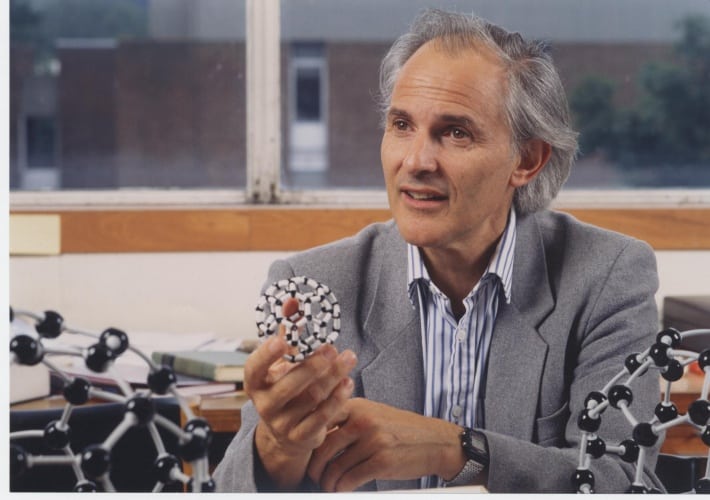 Stuart Nathan
Stuart Nathan
Features Editor
The response to the death of Sir Harry Kroto by mainstream media only confirms his long-held belief that science, engineering and technology are undervalued in the UK

It seems that 2016 is utterly relentless in taking away notable figures. This Saturday saw the death of Sir Harry Kroto, one of Britain’s small but distinguished band of Nobel Laureates, who shared the 1996 Chemistry prize with Robert Curl and Richard Smalley for their discovery of Buckminsterfullerene, the football-shaped hollow sphere of sixty carbon atoms.
For decades students had been taught that pure carbon could exist in two stable forms: diamond and graphite. Kroto, Curl and Smalley dismissed that simple view with the discovery of C60 in the soot formed by directing an intense laser pulse at graphite. In Kroto’s case the discovery was a spin-off into research in radio astronomy, where he had established that large carbon molecules exist in interstellar space, and were particularly common in the atmospheres of red giant stars.
It was Kroto that gave the spheres their name, after the radical American architect Richard Buckminster Fuller, who had designed ‘space-age’ geodesic domes in the 1940s and 50s, and who died in 1983, two years before the trio’s discovery. C60 is now more commonly known as fullerene, or even more familiarly as a buckyball.
Making the jump from pure chemistry to architecture was typical of Kroto, who sustained a keen interest in the arts his whole life, and in fact had a parallel career as a semi-professional graphic designer. He was planning to set up a graphic design studio when he discovered fullerenes; his new-found prominence and the subsequent research it triggered made him change his plans.
Kroto spent most of his career at the University of Sussex, but left in 2004 to take up a professorship at the Florida State University, where he again combined chemistry with astronomy.
Sir Harry wasn’t an engineer. In fact he would probably have bridled at the suggestion; not because of any antipathy towards engineering but because he was a stickler for accuracy. To put it bluntly, he was a man of very firm beliefs who had no problem at all in putting them forward; despite being an approachable and friendly man, woe betide you if you disagreed with him or got something wrong.
But such was the impact of the discovery of fullerenes that Kroto could become one of the most significant names in the history of engineering. By proving that carbon could exist in other stable geometrical structures than graphite and diamond, he paved the way for the research that led to carbon nanotubes and graphene; two materials whose properties are so extraordinary that it seems inevitable they will find some disruptive engineering application in the future, even though currently this is mostly potential.
Science communication was very important to Kroto, and stemmed in large part from his frustration that he thought science wasn’t taken seriously as a part of culture; his decision to leave the UK partly came about because he thought that successive governments underfunded and ignored science. He didn’t just talk about this; he also helped set up two educational programmes, the Vega Science Trust, which created science films including lectures and interviews with eminent scientists, and the Global Educational Outreach for Science, Engineering and Technology.
It’s a particularly grim irony, therefore, that his death went unreported as a news story. Kroto passed away on Saturday and it’s only as I write this on Tuesday afternoon that the major newspapers have begun publishing obituaries. And this for a Nobel Laureate. It’s hard to imagine that the death of a British winner of an Oscar, Booker Prize, Grammy or any other arts award, or a prominent politician, author, actor or musician of similar age, would go unreported in the news pages or by national broadcasters for three days, even over a Bank Holiday weekend.
To put it simply: Sir Harry Kroto was a genius who changed our fundamental understanding of carbon and the universe, was driven away from his adopted country because his work was undervalued, argued and worked tirelessly to improve the standing of science and the public’s knowledge of it, and whose work may have profound effects on the technologies that shape our lives. He deserved better than being ignored until the obituaries desks could get their acts together.




Glasgow trial explores AR cues for autonomous road safety
They've ploughed into a few vulnerable road users in the past. Making that less likely will make it spectacularly easy to stop the traffic for...